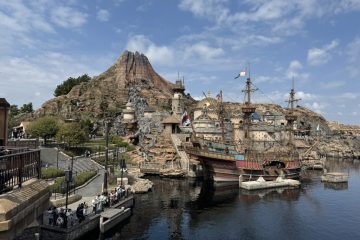We left Bath, Stonehenge and Avebury for the sleepy little town of Beddgelert and Mount Snowdon. Daryl complained about my driving, saying that he had to keep his eyes closed so he would not see “how bad it was”. Of course, he was not willing to try (and I am not sure I wanted to be a passenger with him anyway. Frankly, I think he just wanted to sleep. We had barely stated this trip and we were exhausting him already.
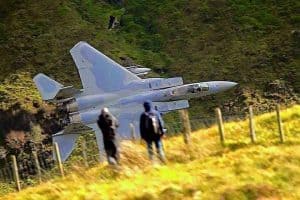
RAF Running the Canyon (not our photo)
We had made a few stops, seeing castles and ruins and small towns. We were approaching the Snowdonia National Park, driving along a ridge with a canyon below. I looked in the rear view and Daryl was “asleep”. Teresa was enjoying the view when all of a sudden we heard a god awful sound. I thought something had gone wrong with the car. It didn’t fee any different and as fast as the sound came, it disappeared. Still, something had been making that noise. I slowed down a bit and rolled down the window. Daryl had woke up and we were looking about when we heard it again. This time, we saw it. It was a fighter jet! The Royal Air Force was running the canyon, below us. Apparently, this is called the Mach Loop and is amazing to watch.
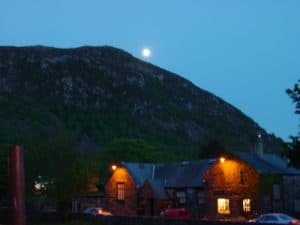
Moon rising over Beddgelert
We got to Beddgelert as the sun was setting and the moon was rising over the hill. Beddgelert was in the mountain area of northern Wales, at the foot of Mount Snowdon.We were tired, me especially so from the drive. We checked into the Bed and Breakfast and immediately hit the sack. We would explore tomorrow.
Beddgelert
Beddgelert is a village and community in the Snowdonia area of Gwynedd, Wales. The population of the community taken at the 2011 census was just 455. It is reputed to be named after the legendary hound Gelert.
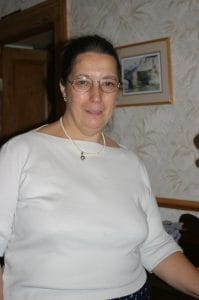
Our Hostess
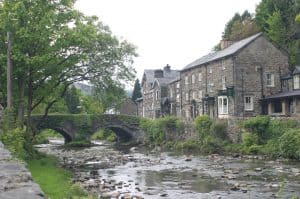
A double arched bridge, leading from the hamlet to grave
Getting up the next morning, we had a hearty breakfast. Daryl was happy as they had meat on the menu, though still had vegetarian options (Teresa had made sure of that). This was a very small town. I would have called it a hamlet or village. Our hostess showed us a picture of Paul and Linda McCartney, who had stayed in the BnB several years ago during a national celebration. She shared with us that the town was founded on the convergence of two rivers and that it had been renamed after a dog. The dog’s grave was across the bridge and in that pasture/park (pointing out the window).
The story goes that a father of a an infant had discovered his child missing. He soon discovered his dog, Gelert, outside covered in blood. He had assumed the worst and in his anger, took the dog away and killed it. Upon returning to his home, he heard the whimpering of a child and went out back of his house to discover his child, sleeping and dreaming, smiling and healthy. Beside him lay a wolf, torn to pieces, bloody and mangled. The father realized it was the dog who protected the child and felt so remorseful, he build a grave and monument for his dog. It was said then that that the dog, a hero, should be immortalized further and they town was renamed.
Of course, we had to go see it.
History
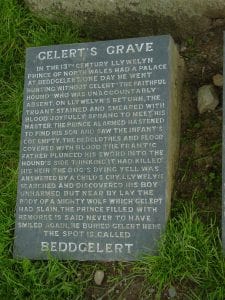 The folk tale of the faithful hound “Gelert” is often associated with the village. A raised mound in the village is called “Gelert’s Grave” and is a significant tourist attraction. But the grave was built by the late 18th-century landlord of the Goat Hotel, David Pritchard, who created it in order to encourage tourism. Similar legends can be found in other parts of Europe and Asia.
The folk tale of the faithful hound “Gelert” is often associated with the village. A raised mound in the village is called “Gelert’s Grave” and is a significant tourist attraction. But the grave was built by the late 18th-century landlord of the Goat Hotel, David Pritchard, who created it in order to encourage tourism. Similar legends can be found in other parts of Europe and Asia.
The village is probably named after an early Christian missionary and leader called Celert (or Cilert) who settled here early in the 8th century. The earliest record of the name Beddgelert appears on a document dated 1258, and the name recorded is “Bekelert”. In a document of 1269 it is recorded as “Bedkelerd”.
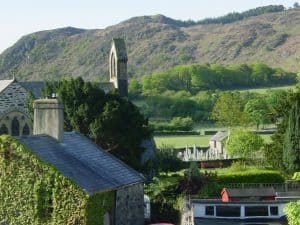 The Church of St. Mary stands at the end of Stryd yr Eglwys (Church Street). This was originally a part of an Augustinian Monastery (the chapel), but is all that remains since the rest of the monastery was burnt down during Edward I’s war of conquest. Rebuilding was probably not completed at the time of the suppression of the monastery in about 1536. Parts of the building date from the 12th century and is still in active use today.
The Church of St. Mary stands at the end of Stryd yr Eglwys (Church Street). This was originally a part of an Augustinian Monastery (the chapel), but is all that remains since the rest of the monastery was burnt down during Edward I’s war of conquest. Rebuilding was probably not completed at the time of the suppression of the monastery in about 1536. Parts of the building date from the 12th century and is still in active use today.
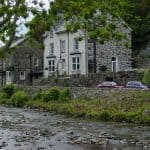 Colwyn Guest House
Colwyn Guest House

Mt Snowdon Summit
Our guest house was just as quiet and cozy as this town was. Teresa still wants to go back, just to get away.
We drove around Mount Snowden to the east along A498 and then turned north on A4086. We were heading to the UK’s only R&P train still operating after 100 years at Llanberis Station. We took the train up to the summit. On the ride up, we had panoramic views of fields, some filled with sheep… of mountain lakes and flowing rivers. It was very scenic. At the summit, it was bear, hardly any scrub and very windy. We were dressed for the cold, but up there it seemed colder as the wind whipped all around.
Mount Snowdon
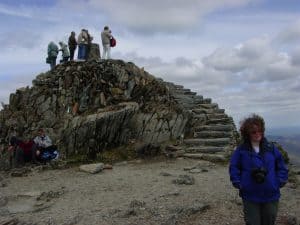 Snowdon is the highest mountain in Wales, at an elevation of 1,085 metres (3,560 ft) above sea level. It is the highest point in the British Isles outside the Scottish Highlands and is located in Snowdonia National Park (Parc Cenedlaethol Eryri) in Gwynedd. It is the busiest mountain in the United Kingdom and the third most visited attraction in Wales, with 582,000 people visiting annually. It is designated as a national nature reserve for its rare flora and fauna.
Snowdon is the highest mountain in Wales, at an elevation of 1,085 metres (3,560 ft) above sea level. It is the highest point in the British Isles outside the Scottish Highlands and is located in Snowdonia National Park (Parc Cenedlaethol Eryri) in Gwynedd. It is the busiest mountain in the United Kingdom and the third most visited attraction in Wales, with 582,000 people visiting annually. It is designated as a national nature reserve for its rare flora and fauna.
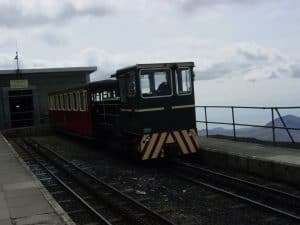 The Snowdon Mountain Railway is a narrow gauge rack and pinion mountain railway that travels for 4.75 miles (7.6 km) from Llanberis to the summit of Snowdon. It is the only public rack and pinion railway in the United Kingdom, and after more than 100 years of operation it remains a popular tourist attraction, carrying more than 130,000 passengers annually. The railway was constructed between December 1894, when the first sod was cut by Enid Assheton-Smith (after whom locomotive No.2 was named), and February 1896, at a total cost of £63,800 (equivalent to £6,775,000 as of 2016).
The Snowdon Mountain Railway is a narrow gauge rack and pinion mountain railway that travels for 4.75 miles (7.6 km) from Llanberis to the summit of Snowdon. It is the only public rack and pinion railway in the United Kingdom, and after more than 100 years of operation it remains a popular tourist attraction, carrying more than 130,000 passengers annually. The railway was constructed between December 1894, when the first sod was cut by Enid Assheton-Smith (after whom locomotive No.2 was named), and February 1896, at a total cost of £63,800 (equivalent to £6,775,000 as of 2016).
We took the train back down, still amazed by the beauty of the land. Daryl was complaining as he had not brought a heavy enough jacket. He also wanted to buy a hiking stock or pole. While we warned him long before the trip started of the walking involved, he still was out of breath quickly. He assured us he had been walking back in AZ.
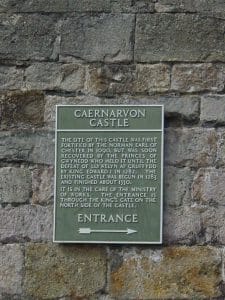 We continued to drive north. We did not have a sight in mind, but we figured since we were over half-way around Mount Snowdon we decided not to back track and move on. We ended up in a town called Caernarfon and followed the signs to the Caernarfon Castle.
We continued to drive north. We did not have a sight in mind, but we figured since we were over half-way around Mount Snowdon we decided not to back track and move on. We ended up in a town called Caernarfon and followed the signs to the Caernarfon Castle.
It was a surprise find, though not totally unexpected. This is England after all and we had passed several castles and such while driving. Some had been turned into hotels, others in ruins. We parked and went in. It was a surreal experience.
Caernarfon Castle
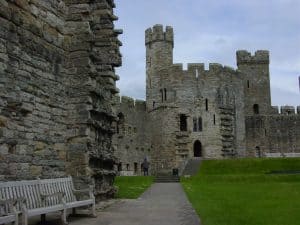 Caernarfon Castle often anglicized as Carnarvon Castle, is a medieval fortress in Caernarfon, Gwynedd, north-west Wales cared for by Cadw, the Welsh Government’s historic environment service. There was a motte-and-bailey castle in the town of Caernarfon from the late 11th century until 1283 when King Edward I of England began replacing it with the current stone structure. The Edwardian town and castle acted as the administrative centre of north Wales and as a result the defences were built on a grand scale. There was a deliberate link with Caernarfon’s Roman past and the Roman fort of Segontium is nearby.
Caernarfon Castle often anglicized as Carnarvon Castle, is a medieval fortress in Caernarfon, Gwynedd, north-west Wales cared for by Cadw, the Welsh Government’s historic environment service. There was a motte-and-bailey castle in the town of Caernarfon from the late 11th century until 1283 when King Edward I of England began replacing it with the current stone structure. The Edwardian town and castle acted as the administrative centre of north Wales and as a result the defences were built on a grand scale. There was a deliberate link with Caernarfon’s Roman past and the Roman fort of Segontium is nearby.
After dinner, we headed back to Beddgelert and got in as it was getting dark. It had been a full day. Tomorrow, we will be heading to Keswick.


